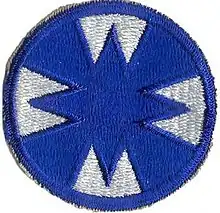| First United States Army Group | |
|---|---|
 Insignia of First United States Army Group | |
| Active | 1943–44 |
| Country | |
| Branch | |
| Type | Army group |
| Role | Military diversion, phantom formation |
| Commanders | |
| Notable commanders | |
First United States Army Group (often abbreviated FUSAG) was a fictitious (paper command) Allied Army Group in World War II prior to D-Day, part of Operation Quicksilver, created to deceive the Germans about where the Allies would land in France. To attract Axis attention, prominent US general George S. Patton was placed in command of the fabricated formation.
History
First U.S. Army Group was activated in London in 1943 as the planning formation for the Allied invasion of France under General Omar Bradley. When Twelfth United States Army Group was activated on 1 August 1944, Bradley and his staff transferred to the headquarters of the new army group. Despite a lack of personnel, FUSAG continued to exist on paper as part of the deception of Operation Quicksilver. In order to make the German forces believe the Allied invasion would come at Pas de Calais, the phantom force was stationed at Dover, directly across the English Channel from the site. To further attract the Axis commanders' attention, General Dwight D. Eisenhower placed George S. Patton in command of the phantom force and increased the formation's apparent size to be larger than the British-led 21st Army Group under Bernard Montgomery. Patton was considered by the Germans to be a formidable offensive commander; he was temporarily unemployed as punishment for slapping a battle-fatigued soldier in Sicily.[1]
The deception worked so well that significant German forces remained in the Pas de Calais region for seven weeks after the real invasion at Normandy to defend against what they thought would be the true invasion force.[2]
Agents infiltrated by Germany into the United Kingdom who became double agents acting for Britain in the Double Cross System—notably Juan Pujol García (Garbo)—played a vital role in persuading the Germans that FUSAG was real. After it had become clear that Normandy, not Calais, was the invasion site, to preserve the credibility of the Double Cross network's agents in spite of the totally false information they had persuaded the Germans to believe, the Germans were persuaded that FUSAG had been real, but had been disbanded and attached to the forces at Normandy because the Normandy "diversion" had been so successful that the Calais landing had become unnecessary.

Subordinate units
What follows is the order of battle for the First United States Army Group at one point during Operation Fortitude. The various formations changed as the operation continued in order to mislead Axis intelligence.
 First United States Army Group
First United States Army Group
 British Fourth Army; fictitious (was real in WWI) – Edinburgh
British Fourth Army; fictitious (was real in WWI) – Edinburgh
 British 2nd Airborne Division; fictitious – Bulford
British 2nd Airborne Division; fictitious – Bulford British VII Corps; notional – Dundee
British VII Corps; notional – Dundee
 55th Infantry Division (United States); fictitious – Iceland
55th Infantry Division (United States); fictitious – Iceland_Badge.svg.png.webp) 80th Division; fictitious – southern England
80th Division; fictitious – southern England 7th, 9th, and 10th US Ranger Battalions; fictitious – Iceland[3]
7th, 9th, and 10th US Ranger Battalions; fictitious – Iceland[3]
 British II Corps; notional – Stirling
British II Corps; notional – Stirling
 55th (West Lancashire) Infantry Division; notional — Three Bridges
55th (West Lancashire) Infantry Division; notional — Three Bridges- 58th Infantry Division; fictitious — Gravesend
 35th Armoured Brigade; notional — Maresfield
35th Armoured Brigade; notional — Maresfield
 US 14th Army; fictitious — Little Waltham
US 14th Army; fictitious — Little Waltham
 9th Airborne Division; fictitious — Leicester
9th Airborne Division; fictitious — Leicester 21st Airborne Division; fictitious — Fulbeck
21st Airborne Division; fictitious — Fulbeck XXXIII Corps; fictitious — HQ Bury St Edmonds
XXXIII Corps; fictitious — HQ Bury St Edmonds
 11th Infantry Division; fictitious — Bury St Edmonds
11th Infantry Division; fictitious — Bury St Edmonds 48th Infantry Division; fictitious — Woodbridge
48th Infantry Division; fictitious — Woodbridge 25th Armored Division; fictitious — East Dereham
25th Armored Division; fictitious — East Dereham
- XXXVII Corps; fictitious — HQ Chelmsford
 17th Infantry Division; fictitious — Hatfield & Peverel
17th Infantry Division; fictitious — Hatfield & Peverel 59th Infantry Division; fictitious — Ipswich
59th Infantry Division; fictitious — Ipswich
- Ninth United States Army; fictitious until 15 April 1944, when the name was taken by a new – real – US field army, which deployed to battle September 1944
See also
References
- ↑ "The Crucial Deception Page 3 - Articles & Publications - Military History Institute - Projects - Dolph Briscoe Center for American History".
- ↑ Ben Macintyre (2012). Double Cross: The True Story of the D-Day Spies. Crown. ISBN 978-0-307-88876-1.
- ↑ Thaddeus Holt. The Deceivers: Allied Military Deception in the Second World War. Phoenix. 2005. ISBN 0-7538-1917-1
Further reading
- Jon Latimer, Deception in War, London: John Murray, 2001
External links
- GlobalSecurity: First US Army Group
- Omar Nelson Bradley, Lt. General FUSAG 12TH AG – Omar Bradley's D-Day June 6, 1944 Maps restored, preserved and displayed at Historical Registry
